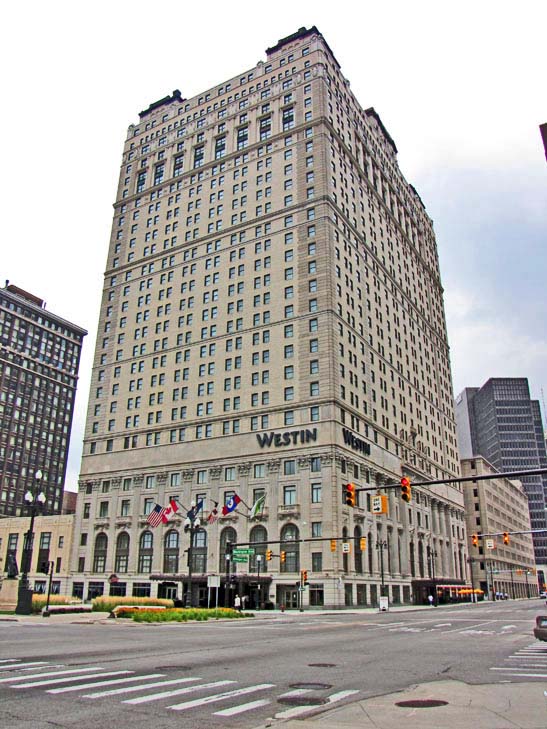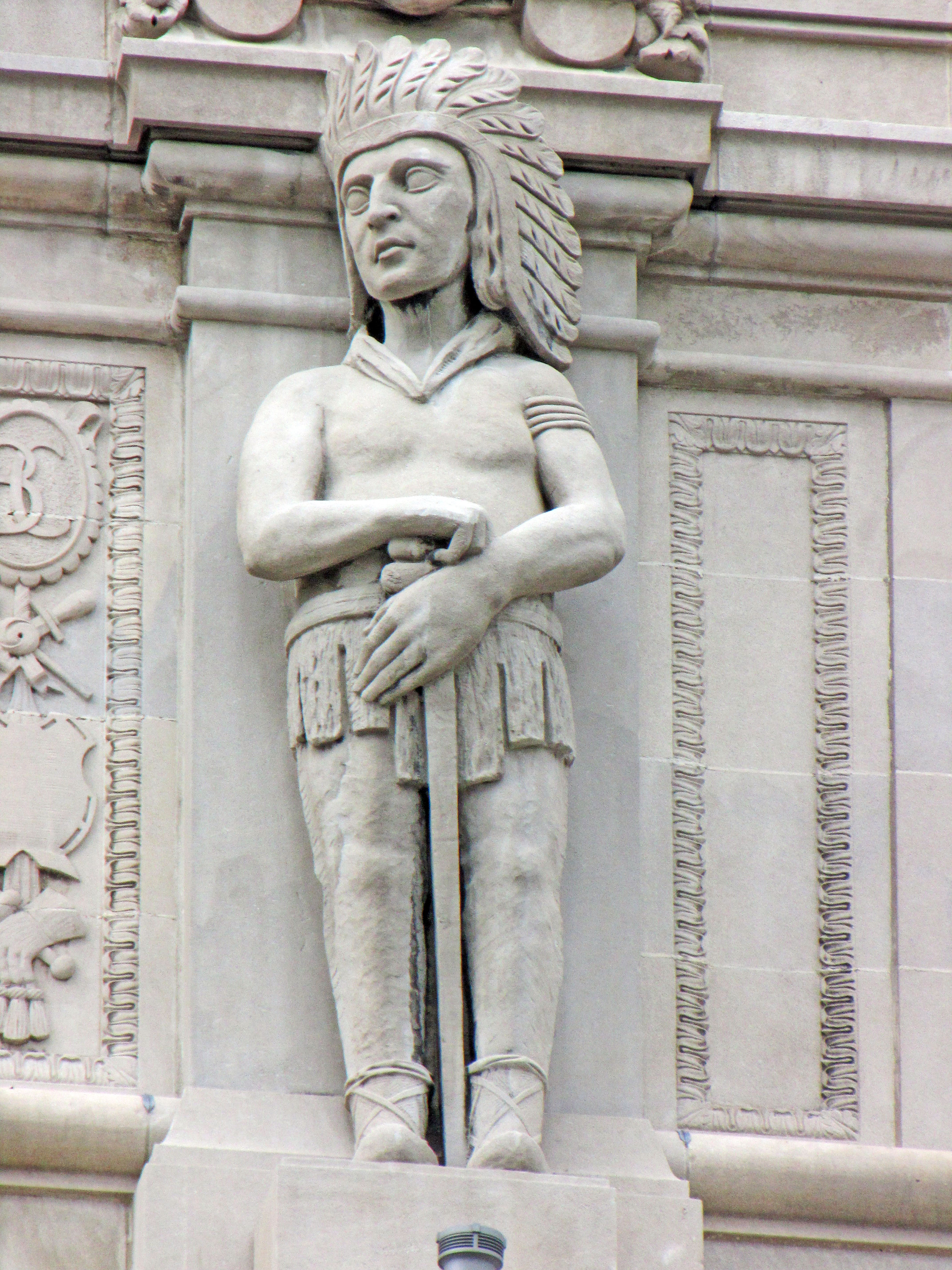

The Book brothers—J. Burgess, Herbert and Frank—developed of a significant slice of downtown Detroit in the first three decades of the Twentieth century. Before Henry Ford successfully marketed his Model T, downtown Detroit was becoming a major center for business and commerce. Skyscrapers and impressive banks were built between the Detroit River and Grand Circus Park, including the Chamber of Commerce Building (1895), the State Savings Bank building (1900), the Penobscot Building (1905), the Ford Building (1909) and the Dime Building (1910). Many cities participated in the City Beautiful movement that emanated from the 1893 World’s Fair in Chicago. The most memorable persisting feature of the effort to bring the City Beautiful movement to Detroit is the Cultural Center.
A Washington Street connecting Michigan Avenue with Grand Circus Park was an original component of Judge Augustus Woodward's plan for Detroit. Edward Bennett, a planner from Chicago, proposed converting the street into a broad Washington Boulevard. The Book brothers saw an opportunity and intended to create a “Fifth
Avenue of the West”—an elegant shopping district lined with impressive
buildin gs providing offices for booming firms. As a result of their efforts,
the Book Building and neighboring Book Tower stand on the west side of Washington
Boulevard and the Industrial Bank Building on the east side while the Book Cadillac Hotel is located at northwest
corner of the intersection of Michigan and Washington Boulevard.
gs providing offices for booming firms. As a result of their efforts,
the Book Building and neighboring Book Tower stand on the west side of Washington
Boulevard and the Industrial Bank Building on the east side while the Book Cadillac Hotel is located at northwest
corner of the intersection of Michigan and Washington Boulevard.
Perhaps the two most elegant hotels in late Nineteenth Century Detroit were the Pontchartrain located at Campus Martius and the Cadillac located where the Book-Cadillac now stands. These older hotels not only lacked modern amenities, but were often presumed to be at risk of fire. The Statler Hotel chain built the city’s first large Twentieth Century hotel, the Statler Hotel, located at the intersection of Washington Boulevard and Grand Circus Park and opened in 1915 and was torn down in 2005. The Book brothers decided that an even more opulent hotel should grace the other end of Washington Boulevard. They purchased the old Cadillac Hotel, but could not immediately raze it since construction materials were unavailable during World War I. When that conflict ended, they tore the Cadillac Hotel down and commissioned Louis Kamper—a student of Sanford White—to design the magnificent building that you see. Kamper had designed all the other buildings the Book Brothers build on Washington Boulevard, as well as the magnificent James Burgess Book home that still stands on East Jefferson.
When opened in 1925, it was the tallest building
in Detroit and the tallest hotel in the world. It was also the nation’s
largest, with 1,136 guest rooms. In an innovation for that era, every room
had its
own water closet.
The ballrooms, dining rooms and other public rooms were extraordinarily elegant,
perhaps the most elegant in the nation at that time. Kamper used an Italian
Renaissance theme throughout, with the lobby done in a Venetian style, while
the grand ballroom was Florentine in its styling. As you observe, Kamper faced
the exterior in stone up to the fifth floor level. On the Michigan Avenue side,
you see the grand entrance with the impressive statues of Antoine Cadillac,
General Anthony Wayne, Robert Navarre and Chief Pontiac standing guard. Toward
the roof, you see the impressive architectural design that Kamper used to cap
this building.
throughout, with the lobby done in a Venetian style, while
the grand ballroom was Florentine in its styling. As you observe, Kamper faced
the exterior in stone up to the fifth floor level. On the Michigan Avenue side,
you see the grand entrance with the impressive statues of Antoine Cadillac,
General Anthony Wayne, Robert Navarre and Chief Pontiac standing guard. Toward
the roof, you see the impressive architectural design that Kamper used to cap
this building.
In the era of rail travel, this was an exceptionally convenient hotel. The Fort Street Station was within walking distance while the Michigan Central and Grand Truck stations were nearby. Travelers to Detroit who wanted to stay at the most desirable hotel went to the Book-Cadillac. And Detroit business people who wanted to scheduled meetings or dinners, opted for this hotel. For decades, one of the most prestigious settings for a wedding or a wedding reception was the Book Cadillac.
The Book Cadillac prospered until the Depression curtailed the nation’s businesses. Many, perhaps most, real estate developers in the Midwest faced bankruptcy in the 1930s. The Books lost control of this hotel in 1931 when the banks foreclosed. Management apparently drastically cut prices and offered rooms for rent as apartments for low fees. Some major Detroit downtown buildings, including the Guardian Building, stood empty during the 1930s. The Book-Cadillac avoided that fate, but was in bankruptcy for most of the Depression.
Because Detroit was the Arsenal of Democracy, the Book-Cadillac prospered during the World War II years and for some time thereafter. By 1959, jets were used for the first time in commercial domestic service, so travel by train quickly sunk to low levels. And, much of post-World II development in metro Detroit occurred in the suburban ring.
In 1951, the Sheraton chain purchased the Book-Cadillac, renamed it the Sheraton-Cadillac, and began to “modernize” the building, but this discouraged preservationists who saw some of the hotel’s great assets removed or remodeled. Post-World War II auto production peaked in 1955 but after that, major shifts occurred in the location of jobs so the later 1960s and 1970s were bleak years for downtown Detroit and, in 1974, the Book Cadillac closed. This followed the closing of two other large nearby hotels: The Pick-Fort Shelby and the Statler-Hilton. The Book Cadillac was sold in 1975 and sold again the next year.
City officials recognized the problem and recruited the Radisson chain to invest in the Book Cadillac. They reopened the business in the late 1970s, but the customer base was not there so they announced a 1979 closing. That would have left the city with just one downtown hotel—the Pontchartrain built in 1965. Mayor Coleman Young worked extremely diligently with the Republican Party and convinced them to hold their 1980 convention in the Motor City—the convention that nominated Ronald Reagan. The mayor knew that he needed downtown hotels, so much to the displeasure of many of his constituents who favored neighborhood rather than downtown development, he pumped city funds into the Book Cadillac. It was money-losing adventure and so the Book-Cadillac’s closed in 1983. Plans were announced in 1984 to modernize the building into 12 floors of hotel rooms and 11 floors of offices. Nothing came of those plans. Subsequently, the Young administration sought funds to tear it down as an eyesore, but that is a very costly task, so it was not demolished.
There was a rebirth of activity in downtown Detroit after 1999. General Motors moved into the Renaissance Center, first Comerica Park and then Ford Field opened for professional sports and three casinos began to lure suburban investors and gamblers to downtown. Downtown developers attracted Major League baseball's All-Star game, the Super Bowl and the Final Four basketball tournament of the National Collegiate Athletic Association to Detroit. A need arose for more hotel space.
In July, 2003, Mayor Kwame Kilpatrick and
the City of Detroit announced they had entered into an agreement with the
Kimberly-Clark company for a $150 million renovation of the Book-Cadillac.
Presumably, there would be extensive tax credits that would benefit all parties.
Work began but it stopped in November, 2003. The reported reason was that
the early work led to a finding that renovation would much more expensive
than thought. It is also possible that some tax credits turned out to be
less generous than presumed. Nothing happened for two years. In June, 2005,
a Cleveland development group, the Ferchill Group led by John Ferchill, explored
the opportunity to remodel the hotel. Ferchill subsequently announced a new
plan for restoring the glory of the hotel. This involved state and federal
tax credits of $33 million, brownfield tax credits of $8.5 million and about
$111 million in private financing. Ferchill's group apparently invested $8
million, while a private equity firm, iStar Financial, invested very much
more. The City of Detroit agreed to spend $20 million to build a parking
facility nearby. Remodeling began in August, 2006, and in October, 2008,
the spectacularly updated Book-Cadillac opened its doors as a Westin Hotel.
The building includes three stories of remodeled public spaces, including
new restaurants and bars, 453 hotel rooms and 64 condominiums on the upper
floors.
The Book-Cadillac Hotel has historical significance to baseball
fans. During prohibition, Detroit was a favorite location for baseball players
who enjoyed
liquid refreshments since the supply from Canada was limitless and of exceptional
quality. Pages could be written about the enjoyable evenings that
Babe Ruth apparently spent at the Book Cadillac with his colleagues when the
Yankees visited Detroit. More important is the date May 2, 1939. On June 2,
1925, Lou Gehrig began his consecutive game streak. That is, he started every
game the Yankees played from 1925 through the end of the 1938 season. His performance
tailed off a bit in 1938, but he finished that year with a .295 batting average,
29 home runs and 114 runs batted in. Spring training did not go well for the
Iron Horse in 1939 and, in the Yankees first 8 games in April of that year;
he had only four hits in 28 at-bats. It was obvious to him, and to his teammates,
that something was wrong with his performance.
The Yankees arrived by train from New York on May 2 and checked into the Book-Cadillac for a series of games that began that afternoon. A sports writer for the Detroit Times, Bob Murphy, went to the Book-Cadillac, sought out Lou Gehrig and asked him about his unusually poor performance. Gehrig discussed the issue at length and admitted that he was not doing well at all. Perhaps that prompted his decision for, shortly thereafter; Gehrig sought out his manager, Joe McCarthy, and told him that he would not play that afternoon. Thus ended the career—and 2,130 consecutive game streak—of one of the most talented and popular man to play baseball. That afternoon, his teammates, the Detroit Tiger players and the 11,000 fans at Briggs Stadium recognized what was happening and cheered for Gehrig. Just three months later, specialists at Mayo Clinic diagnosed the amyotrophic lateral sclerosis that was to claim Gehrig’s life twenty five months later. Wally Pipp was the Yankee first basemen, who lost his job to Lou Gehrig in June, 1925. Although trained as an architect, after he finished his baseball career Pipp returned to his native Grand Rapids and became a business man. Duties called him to Detroit on May 2, 1939, but he found time to get out to Briggs Stadium to watch his team old team play the Tigers. Pipp witnessed the start of Gehrig’s streak from the Yankees bench and then the end, but this time from the grandstand at Michigan and Trumbull.
Architect: Louis Kamper
Architectural style: Highly decorated modern hotel with Italian Renaissance embellishments
Date of Construction: 1924
Use in 2005: Elegant upscale hotel and
lofts
City of Detroit Local Historic District: Not listed
State of Michigan Registry of Historic Sites: Not listed
National Registry of Historic Places: Not listed
Website: http://www.bookcadillacwestin.com/
Book: Detroit’s Statler and Book-Cadillac Hotels: The Anchors of Washington
Boulevard by David Kohrman (Arcdia, 2003)
Picture: Ren Farley; July 7, 2005
Description updates: January 12, 2009